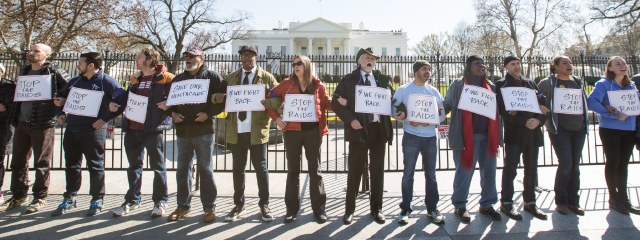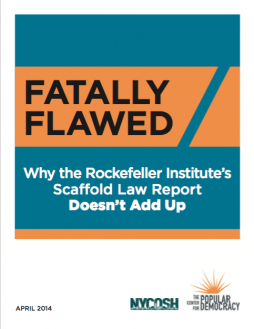Fatally Flawed: Why the Rockefeller Institute’s Scaffold Law Report Doesn’t Add Up
Summary
New York State’s Labor Law §240 (commonly known as the Scaffold Law) helps keep workers safe by holding employers and owners liable if unsafe conditions at their worksites result in injuries or death of workers working at an elevation. The law is crucial: falls from elevations kill more than one-third of all construction workers killed at work, by far the leading cause of on-the-job deaths in the industry.
The construction industry has been trying for years to water down New York’s critical protections of workers’ health and safety. Most recently, those lobbying to weaken New York’s worker safety laws have trumpeted the findings of a report published by the Rockefeller Institute and funded by the so-called New York Civil Justice Institute, which paid $82,800 to commission the report and is a poorly-disguised front group for the right-wing Lawsuit Reform Alliance of New York.
The Cost of Labor Law 240 on New York’s Economy and Public Infrastructure takes a far-fetched approach: blaming New York’s strong safety laws for allegedly causing more accidents. Professor Richard W. Hurd, Professor and Associate Dean at the Cornell University School of Industrial and Labor Relations, called this argument “counterintuitive,” asking, “If employers are financially liable for injury and death, would they not be more likely to invest in safety?”
Common sense tells us that industry hazards, not worker protection laws, cause injuries on the job. A look at the evidence confirms this. The October 2013 report Fatal Inequality, published by the Center for Popular Democracy, starkly illustrates how important the Scaffold Law is because of the ongoing rates of injury in construction in New York and, notably, how the risks are disproportionately borne by immigrant workers and workers of color.
Meaningful worker protection requires putting responsibility where it belongs: on the employers and site owners who control the worksite and can ensure proper protective equipment, training, and safety measures are provided and followed. This is precisely what New York’s Scaffold Law does. The Rockefeller study tries to distract from the common sense importance of New York’s law with analysis full of flaws and misstatements. Below, we detail a number of the key flaws that debunk the report’s incredible assertion that New York’s scaffold law, not industry hazards, cause worker injuries.
NYCOSH & CPD also released a new one-pager explaining how the Scaffold Safety Law works, read it here.













